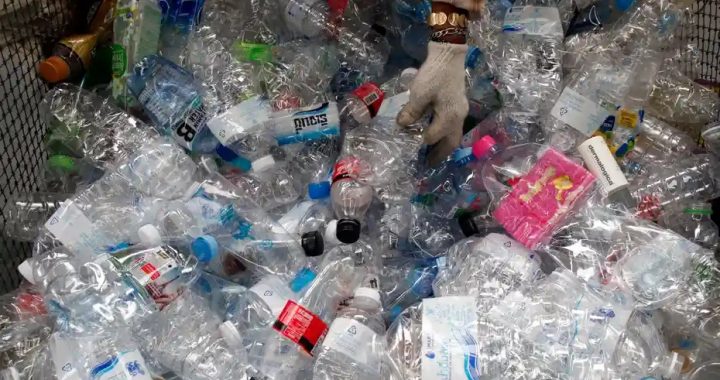Microplastic and nanoplastic particles are now discoverable in human organs thanks to a new technique.
Microplastics have polluted the entire planet, from Arctic snow and Alpine soilsto the deepest oceans. People are also known to consume them via food and water, and to breathe them in, but the potential impact on human health is not yet known.
The researchers expect to find the particles in human organs and have identified chemical traces of plastic in tissue. But isolating and characterising such minuscule fragments is difficult, and contamination from plastics in the air is also a challenge.
To test their technique, they added particles to 47 samples of lung, liver, spleen and kidney tissue obtained from a tissue bank established to study neurodegenerative diseases. Their results showed that the microplastics could be detected in every sample.
The scientists, whose work is being presented at a meeting of the American Chemical Society on Monday, said their technique would enable other researchers to determine contamination levels in human organs around the world.
“It would be naive to believe there is plastic everywhere but just not in us,” said Rolf Halden at Arizona State University. “We are now providing a research platform that will allow us and others to look for what is invisible – these particles too small for the naked eye to see. The risk [to health] really resides in the small particles.”
The analytical method developed allows the researchers to identify dozens of types of plastic, including the polyethylene terephthalate (PET) used in plastic drinks bottles and the polyethylene used in plastic bags.
They found bisphenol A (BPA), a chemical used to make plastics, in all 47 samples. The US Environmental Protection Agency is concerned about BPA because “it is a reproductive, developmental and systemic toxicant in animal studies”. The researchers examined lung, liver, spleen and kidney tissue as these organs are likely to be exposed to microplastics or collect them.
“We never want to be alarmist, but it is concerning that these non-biodegradable materials that are present everywhere [may] enter and accumulate in human tissues, and we don’t know the possible health effects,” said Varun Kelkar of Arizona State University, part of the research team.
“Once we get a better idea of what’s in the tissues, we can conduct epidemiological studies to assess human health outcomes,” he said. “That way, we can start to understand the potential health risks, if any.”
Charles Rolsky, another member of the team, said: “In a few short decades, we’ve gone from seeing plastic as a wonderful benefit to considering it a threat.”
Microplastics are those less than 5mm in diameter and nanoplastics have a diameter of less than 0.001mm. Both form largely from the abrasion of larger pieces of plastic dumped into the environment. Research in wildlife and laboratory animals has linked exposure to tiny plastics to infertility, inflammation and cancer.
The researchers are now testing tissues to find microplastics that accumulated during donors’ lifetimes. Donors to tissue banks often provide information on their lifestyles, diets and occupations, so this may help future work to determine the main ways in which people are exposed to microplastics.
The new methodology developed by the team to extract plastics from the tissues and analyse them will be shared online so other researchers can report their results in a standardised way. “This shared resource will help build a plastic exposure database so that we can compare exposures in organs and groups of people over time and geographic space,” said Halden.
Previous studies have shown people eat and breathe in at least 50,000 particles of microplastic a year and that microplastic pollution is raining down on city dwellers, with London, UK, having the highest level of four cities analysed last year. The particles can harbour toxic chemicals and harmful microbes and are known to harm some marine creatures.
Other work has shown different kinds of nanoparticles from air pollution are present in human hearts and brains, and have been linked to brain cancer.
81 days to save the Earth …
… we’re all in. Are you? On November 4, a day after the presidential election, the US will formally withdraw from the Paris agreement on constraining global heating. It’s urgent that we tell the world what this means, and the Guardian is pulling out all the stops to do so. Will you help us by supporting our journalism?
Millions are flocking to the Guardian every day. Financial support from our readers is crucial in enabling us to produce open, fearless, independent reporting that addresses the climate emergency. It helps sustain the freedom we have to present the facts comprehensively, explain the details as they unfold, and interrogate the decisions made.
The Guardian recognises the climate emergency as the defining issue of our times. That’s why we have pledged to give climate change, wildlife extinction and pollution the sustained attention and prominence they demand, as a core part of our journalism.
At this pivotal moment for our planet, our independence enables us to always inform readers about threats, consequences and solutions based on scientific fact, not political prejudice or business interests. This makes us different. And we are equally determined to practice what we preach: we have divested from the oil and gas sectors, renounced fossil fuel advertising and committed to achieving carbon neutrality by 2030.
We believe everyone deserves access to information that is fact-checked, and analysis that has authority and integrity. That’s why, unlike many others, we made a choice: to keep Guardian reporting open for all, regardless of where they live or what they can afford to pay. Our work would not be possible without our readers, who now support our work from 180 countries around the world.
Every reader contribution, however big or small, is so valuable for our future.



